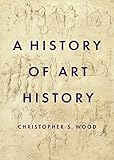A History of Art History / Christopher S. Wood.
Material type: TextPublisher: Princeton, NJ : Princeton University Press, [2019]Copyright date: ©2019Description: 1 online resource (472 p.) : 24 b/w illusContent type:
TextPublisher: Princeton, NJ : Princeton University Press, [2019]Copyright date: ©2019Description: 1 online resource (472 p.) : 24 b/w illusContent type: - 9780691156521
- 9780691194318
- 709 23
- online - DeGruyter
- Issued also in print.
| Item type | Current library | Call number | URL | Status | Notes | Barcode | |
|---|---|---|---|---|---|---|---|
 eBook
eBook
|
Biblioteca "Angelicum" Pont. Univ. S.Tommaso d'Aquino Nuvola online | online - DeGruyter (Browse shelf(Opens below)) | Online access | Not for loan (Accesso limitato) | Accesso per gli utenti autorizzati / Access for authorized users | (dgr)9780691194318 |
Browsing Biblioteca "Angelicum" Pont. Univ. S.Tommaso d'Aquino shelves, Shelving location: Nuvola online Close shelf browser (Hides shelf browser)

|

|

|

|

|

|

|
||
| online - DeGruyter The Nuclear Borderlands : The Manhattan Project in Post-Cold War New Mexico New Edition / | online - DeGruyter The River Twice : Poems / | online - DeGruyter Worlds Enough : The Invention of Realism in the Victorian Novel / | online - DeGruyter A History of Art History / | online - DeGruyter Peaceful Families : American Muslim Efforts against Domestic Violence / | online - DeGruyter Michelangelo, God's Architect : The Story of His Final Years and Greatest Masterpiece / | online - DeGruyter Papers of Thomas Jefferson. 44, The Papers of Thomas Jefferson, Volume 44 ; 1 July to 10 November 1804 / |
Frontmatter -- Contents -- Introduction -- 800-1400 -- 1400-1500 -- 1500-1550 -- 1550-1600 -- 1600-1650 -- 1650-1700 -- 1700-1750 -- 1750-1770 -- 1770-1790 -- 1790-1810 -- 1810-1830 -- 1830-1850 -- 1850-1870 -- 1870-1890 -- 1890-1900 -- 1900-1910 -- 1910-1920 -- 1920-1930 -- 1930-1940 -- 1940-1950 -- 1950-1960 -- Conclusions: Novissima -- References -- Index -- Photo Credits
restricted access online access with authorization star
http://purl.org/coar/access_right/c_16ec
An authoritative history of art history from its medieval origins to its modern predicamentsIn this wide-ranging and authoritative book, the first of its kind in English, Christopher Wood tracks the evolution of the historical study of art from the late middle ages through the rise of the modern scholarly discipline of art history. Synthesizing and assessing a vast array of writings, episodes, and personalities, this original and accessible account of the development of art-historical thinking will appeal to readers both inside and outside the discipline.The book shows that the pioneering chroniclers of the Italian Renaissance-Lorenzo Ghiberti and Giorgio Vasari-measured every epoch against fixed standards of quality. Only in the Romantic era did art historians discover the virtues of medieval art, anticipating the relativism of the later nineteenth century, when art history learned to admire the art of all societies and to value every work as an index of its times. The major art historians of the modern era, however-Jacob Burckhardt, Aby Warburg, Heinrich Wölfflin, Erwin Panofsky, Meyer Schapiro, and Ernst Gombrich-struggled to adapt their work to the rupture of artistic modernism, leading to the current predicaments of the discipline.Combining erudition with clarity, this book makes a landmark contribution to the understanding of art history.
Issued also in print.
Mode of access: Internet via World Wide Web.
In English.
Description based on online resource; title from PDF title page (publisher's Web site, viewed 21. Jun 2021)


